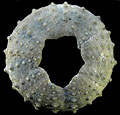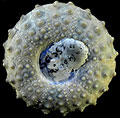The Echinoid Directory
Gauthiosoma Kutscher, 1985, p. 524
| Diagnostic Features |
|
|---|---|
| Distribution | Upper Cretaceous (Campanian-Maastrichtian) to Palaeocene, Europe and central Asia. |
| Name gender | neuter |
| Type | Cidarites (Diadema) princeps von Hagenow, 1840, p. 651, by original designation. |
| Species Included |
|
| Classification and/or Status |
|
| Remarks |
|





